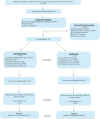Role of high-dose methylprednisolone in Zargar Grade IIB corrosive esophageal burns: A randomized control study
- PMID: 38343516
- PMCID: PMC10852135
- DOI: 10.4103/tjem.tjem_134_23
Role of high-dose methylprednisolone in Zargar Grade IIB corrosive esophageal burns: A randomized control study
Abstract
Objective: The objective of the study is to test the efficacy of high-dose methylprednisolone in the prevention of esophageal stricture after corrosive ingestion.
Methods: This study was a single-center, randomized controlled single-blinded study. Simple randomization was done with 15 adult patients (>18 years) in each arm, who presented with a history of corrosive ingestion within the past 24 h and had esophageal injury of Zargar Grade IIB on endoscopy. Intravenous methylprednisolone 1 g/day for 3 days was given to the intervention arm while 100 mL of normal saline was given as placebo in control arm. Follow-up to diagnose esophageal stricture was done at 8 weeks.
Results: Thirty patients (15 in each arm) were recruited for the study. As per the intention to treat analysis, 33% and 46.6% developed stricture in the intervention and control arm, respectively (relative risk [RR] = 0.714; 95% confidence interval 0.29-1.75; P = 0.462). 40% patients in control group and 7.7% in intervention group had undergone feeding jejunostomy, which was statistically significant with a p-value of 0.048. Airway injury showed significant clinical improvement in the intervention arm but the difference was nonsignificant statistically (P = 0.674). There was no increased incidence of hypertension, hyperglycemia, hyponatremia, hyperkalemia, or infections in intervention arm.
Conclusion: Methylprednisolone does not help in the prevention of stricture formation in corrosive esophageal injury, but it significantly reduces the requirement of feeding jejunostomy and has a beneficial role in treating airway injury.
Keywords: Airway injury; Zargar classification; corrosive ingestion; esophageal burns; steroids; stricture.
Copyright: © 2024 Turkish Journal of Emergency Medicine.
Conflict of interest statement
None Declared.
Figures
Similar articles
-
High doses of methylprednisolone in the management of caustic esophageal burns.Pediatrics. 2014 Jun;133(6):E1518-24. doi: 10.1542/peds.2013-3331. Pediatrics. 2014. PMID: 24864182 Clinical Trial.
-
[High doses of steroids in the management of caustic esophageal burns in children].Arch Pediatr. 2004 Jan;11(1):13-7. doi: 10.1016/j.arcped.2003.10.011. Arch Pediatr. 2004. PMID: 14700754 Clinical Trial. French.
-
Emergency Computed Tomography Predicts Caustic Esophageal Stricture Formation.Ann Surg. 2019 Jul;270(1):109-114. doi: 10.1097/SLA.0000000000002732. Ann Surg. 2019. PMID: 29533267 Clinical Trial.
-
Should computerised tomography replace endoscopy in the evaluation of symptomatic ingestion of corrosive substances?Clin Toxicol (Phila). 2014 Nov;52(9):911-25. doi: 10.3109/15563650.2014.957310. Epub 2014 Sep 16. Clin Toxicol (Phila). 2014. PMID: 25224219 Review.
-
Household cleaning products poisoning in a pediatric emergency center: A 10- year cross-sectional study and literature review.Pediatr Neonatol. 2021 Nov;62(6):638-646. doi: 10.1016/j.pedneo.2021.05.026. Epub 2021 Jul 16. Pediatr Neonatol. 2021. PMID: 34332912 Review.
Cited by
-
Short-term and long-term management of caustic-induced gastrointestinal injury: An evidence-based practice guidelines.Indian J Gastroenterol. 2025 Feb 21. doi: 10.1007/s12664-024-01692-1. Online ahead of print. Indian J Gastroenterol. 2025. PMID: 39982600
References
-
- Zargar SA, Kochhar R, Mehta S, Mehta SK. The role of fiberoptic endoscopy in the management of corrosive ingestion and modified endoscopic classification of burns. Gastrointest Endosc. 1991;37:165–9. - PubMed
-
- Lurie Y, Slotky M, Fischer D, Shreter R, Bentur Y. The role of chest and abdominal computed tomography in assessing the severity of acute corrosive ingestion. Clin Toxicol (Phila) 2013;51:834–7. - PubMed
LinkOut - more resources
Full Text Sources
Research Materials
Miscellaneous

